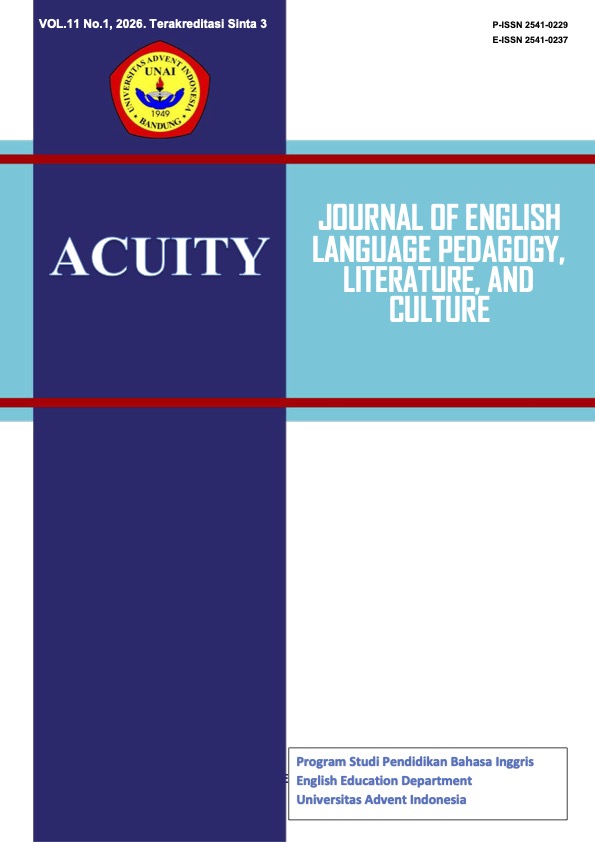Students’ Perception of Using English Movies as Media for Increasing Idiomatic Expressions Acquisition
Keywords:
English Movies, Idiom Acquisition, Idiomatic Expression, More Knowledgeable Others, Student PerceptionAbstract
This study explores how students use idioms acquired from English movies to improve communication skills and how More Knowledgeable Other, henceforth mentioned as MKO, helped students comprehend the idioms. The Optimal Input Hypothesis by Krashen and Mason (2020) and the Sociocultural Theory by Vygotsky (1978) were the theoretical basis for conducting the research. The survey was conducted using an open-ended questionnaire distributed online to UNNES' English Literature and English Education students who enjoy watching English movies and have passed Idiom-Based Lexical Studies course. The thematic analysis method proposed by Braun and Clarke (2006) was used to analyze the collected data. The result of the study shows that most of the participants agree that English movies help them acquire more idiomatic expressions supported by human and technological scaffolding. Participants also shared that the idiomatic expressions acquired from English movies improve their communication and writing skills. This research reveals that giving more input from English movies encourages students to use idioms in both spoken and written expressions. In addition, MKOs play roles in supporting students' process of understanding idiomatic expressions acquired from English movies, and the more preferred one is technology MKO.
Downloads
References
Alfaiz, M. K., Said, I., & Irianti, L. (2025). Exploring how exposure to pop culture English movies enriches vocabulary. Journal of English Education Program (JEEP), 12(1), 56. https://doi.org/10.25157/(jeep).v12i1.17815
Aljebreen, S., & Alzamil, A. (2022). The impact of using short films on learning idioms in EFL classes. World Journal of English Language, 12(7), 250. https://doi.org/10.5430/wjel.v12n7p250
Amos, N. T., & Abas, I. H. (2021). Idiom comprehension using multimodal teaching approach among Zanzibar University students. Advances in Language and Literary Studies, 12(3), 82. https://doi.org/10.7575/aiac.alls.v.12n.3.p.82
Anisa, R., Innayatullah, R. K., Taufiquddin, Muh., & Budairi, A. (2023). Investigating the use of kid movies to scaffold learners’ engagement and vocabulary enrichment. International Undergraduate Conference on English Education, 2(1), 76–82. https://doi.org/10.12928/iucee2022.v2i1.13869
Bahadirovna, I. Y. (2023). The importance of idioms in modern English as a part of everyday language. International Journal of Inclusive and Sustainable Education, 2(11), 66–68. https://doi.org/10.51699/ijise.v2i11.2903
Braun, V., & Clarke, V. (2006). Using thematic analysis in psychology. Qualitative Research in Psychology, 3(2), 77–101. https://doi.org/10.1191/1478088706qp063oa
Cicconi, M. (2014). Vygotsky meets technology: A reinvention of collaboration in the early childhood mathematics classroom. Early Childhood Education Journal, 42(1), 57–65. https://doi.org/10.1007/s10643-013-0582-9
Daneshfard, F., Khosravian, E., Alimorad, Z., Honarparvaran, M., & Tabe Bordbar, F. (2021). Watching English movies and proficiency development: Advanced learners’ perceptions and strategies. Global Journal of Foreign Language Teaching, 11(2), 109–123. https://doi.org/10.18844/gjflt.v11i2.5660
Fitriati, S. W., & Wahyuni, S. (2018). Lexical Bundles in Whatsapp Conversation between Native and Non-Native Speakers of English. Proceedings of the UNNES International Conference on English Language Teaching, Literature, and Translation (ELTLT 2018), 314–320. https://doi.org/10.2991/eltlt-18.2019.61
Huang, H. L. (2024). Exploring the impact of VR scaffolding on EFL teaching and learning: Anxiety reduction, perceptions, and influencing factors. Multimodal Technologies and Interaction, 8(10), 85. https://doi.org/10.3390/mti8100085
Juhansar, J., Budiarti, B., Hashim, S. bin, Reriansyah, & Sihole, I. G. (2024). Cinematic learning-teaching: The role of English movies in vocabulary acquisition for EFL learners. International Journal of Business, Humanities, Education and Social Sciences (IJBHES), 6(1), 79–87. https://doi.org/https://doi.org/10.46923/ijbhes.v6i1.351
Katemba, C. V., & Ning, W. (2018). Students` responses in enhancing new vocabulary through subtitled English movies. Acuity: Journal of English Language Pedagogy, Literature and Culture, 3(1), 45-75. https://doi.org/10.35974/acuity.v3i1.623
Krashen, S., & Mason, B. (2020, May). Input hypothesis: Not all comprehensible input is of equal value. CATESOL Newsletter, 1–2.
Lestari. Anggun, Latifah, N., & Rahman, A. A. M. (2023). The use of YouTobe media in improving students’ vocabulary through online learning. Linguamedia Journal, 4(2), 1–11. https://doi.org/https://dx.doi.org/10.56444/lime.v4i02.4000
Mehdi, S. (2024). Techniques used in teaching idioms. Acta Globalis Humanitatis et Linguarum, 1(2), 34–42. https://doi.org/10.69760/aghel.01024063
Sari, S. N., & Aminatun, D. (2021). Students’ perception on the use of English movies to improve vocabulary mastery. Journal of English Language Teaching and Learning, 2(1), 16–22. https://doi.org/10.33365/jeltl.v2i1.757
Sarıoğlu, F., & Altunbaş Yavuz, S. (2023). The effect of using digital story in teaching proverbs and idioms to primary school students. E-Kafkas Eğitim Araştırmaları Dergisi, 10(3), 520–531. https://doi.org/10.30900/kafkasegt.1359384
Ta’amneh, M. A. A. A. (2021). Strategies and difficulties of learning English idioms among university students. Journal of Education and Practice, 12(23). https://doi.org/10.7176/JEP/12-23-10
Tayşı, E., Hamamcıoğlu, T., & Gürkaya, Z. (2025). Exploring EFL instructors’ awareness and perceptions of using ChatGPT in language education. Acuity: Journal of English Language Pedagogy, Literature, and Culture, 10(2), 165–180. https://doi.org/doi.org/10.35974/acuity.v10i2.3405
Vygotsky, L. S. (1978). Mind in society: Development of higher psychological processes (M. Cole, Ed.). Harvard University Press.
Wahyuningtyas, D. (2021). Eliciting idiom retention through alliteration in a classroom activity. English Learning Innovation, 2(2), 43–51. https://doi.org/10.22219/englie.v2i2.17065
Wu, W.-C. V., Lin, I.-T. D., Marek, M. W., & Ou Yang, F.-C. (2021). Analysis of English idiomatic learning behaviors of an audio-visual mobile application. Sage Open, 11(2). https://doi.org/10.1177/21582440211016899
Yeganehpour, P., & Zarfsaz, E. (2022). The Effect of using de-contextualization and semi-contextualization teaching techniques on Turkish EFL learners’ vocabulary learning. Acuity: Journal of English Language Pedagogy, Literature and Culture, 7(2), 161–178. https://doi.org/10.35974/acuity.v7i2.2781
Zarena, A. (2022). The role of idioms and phrasal verbs in communicative competence. Frontline Social Sciences and History Journal, 02(12), 69–75. https://doi.org/10.37547/social-fsshj-02-12-08

















